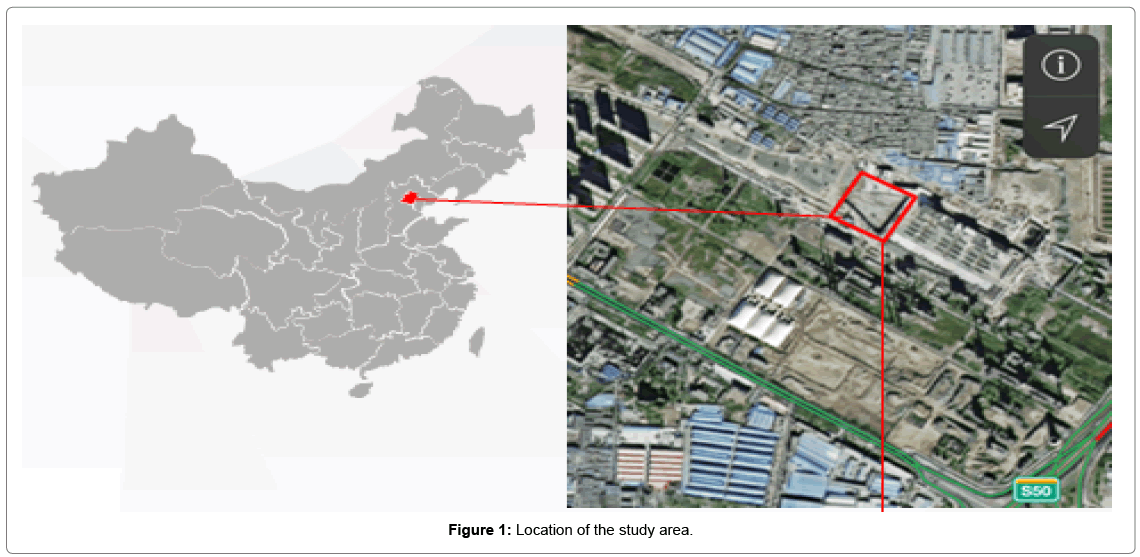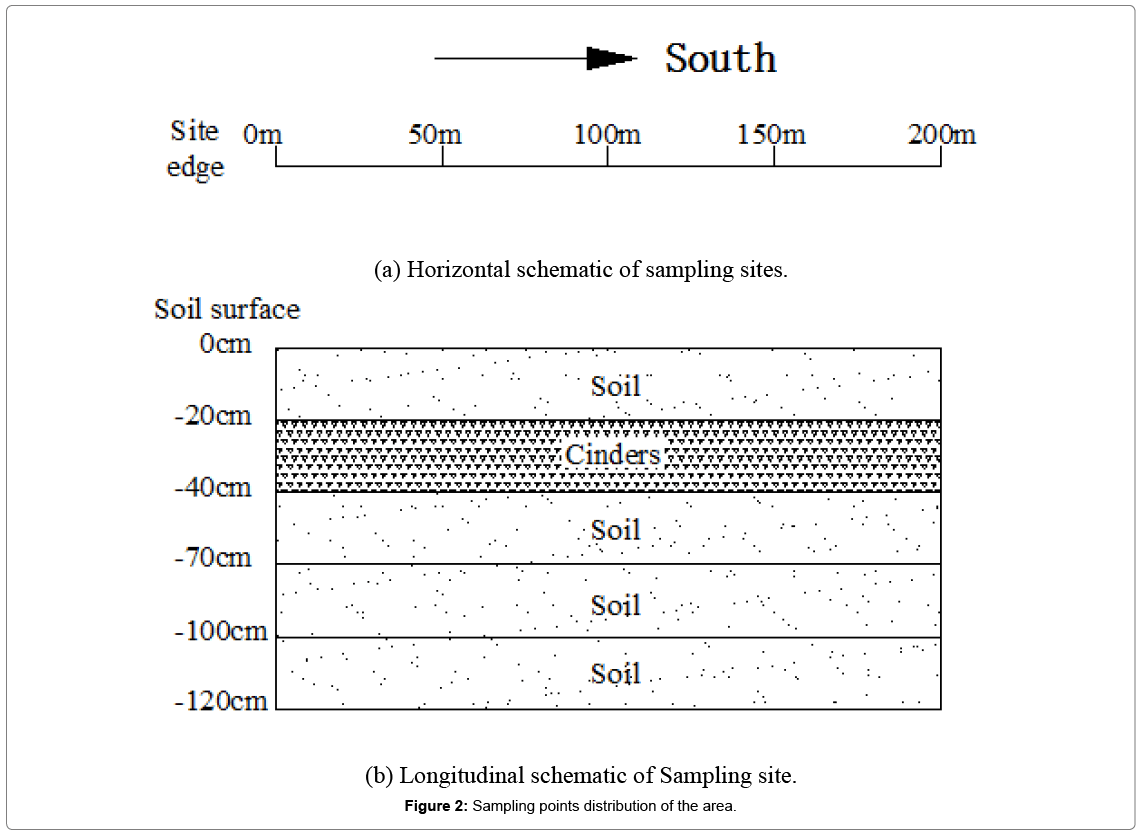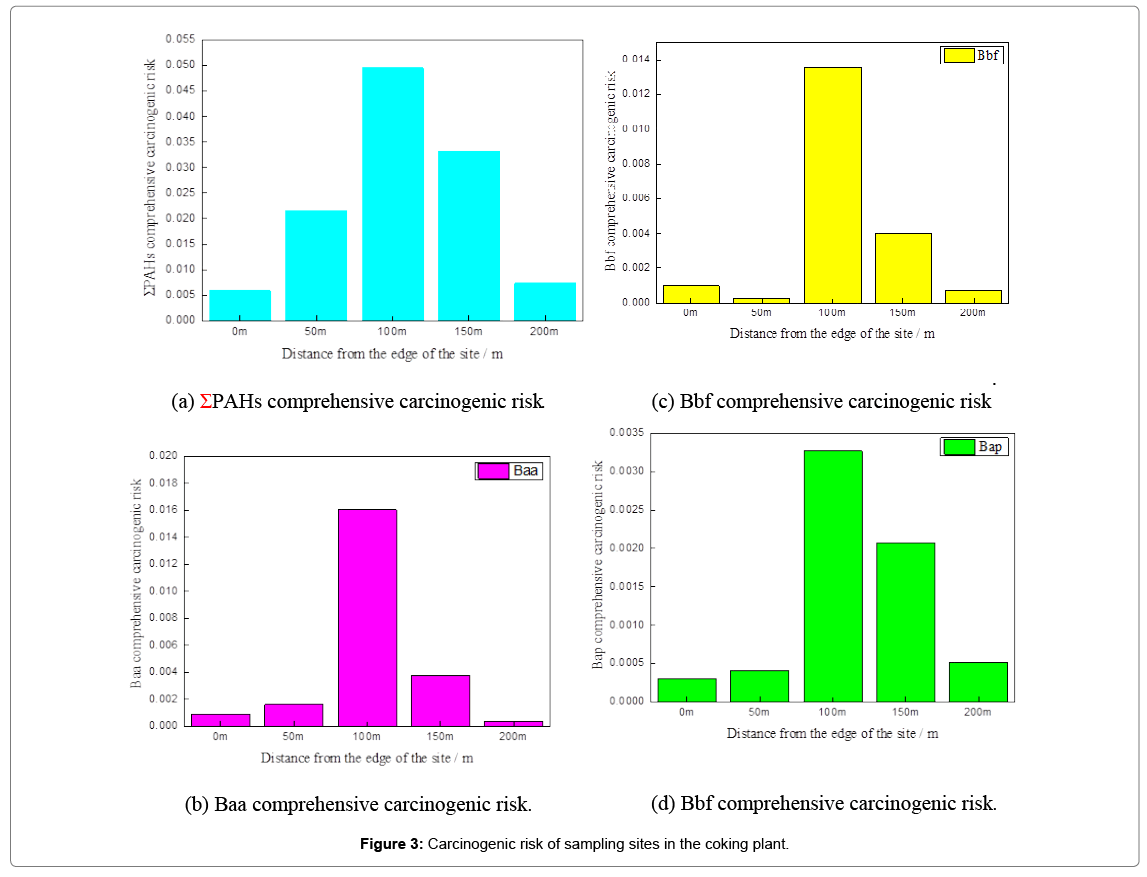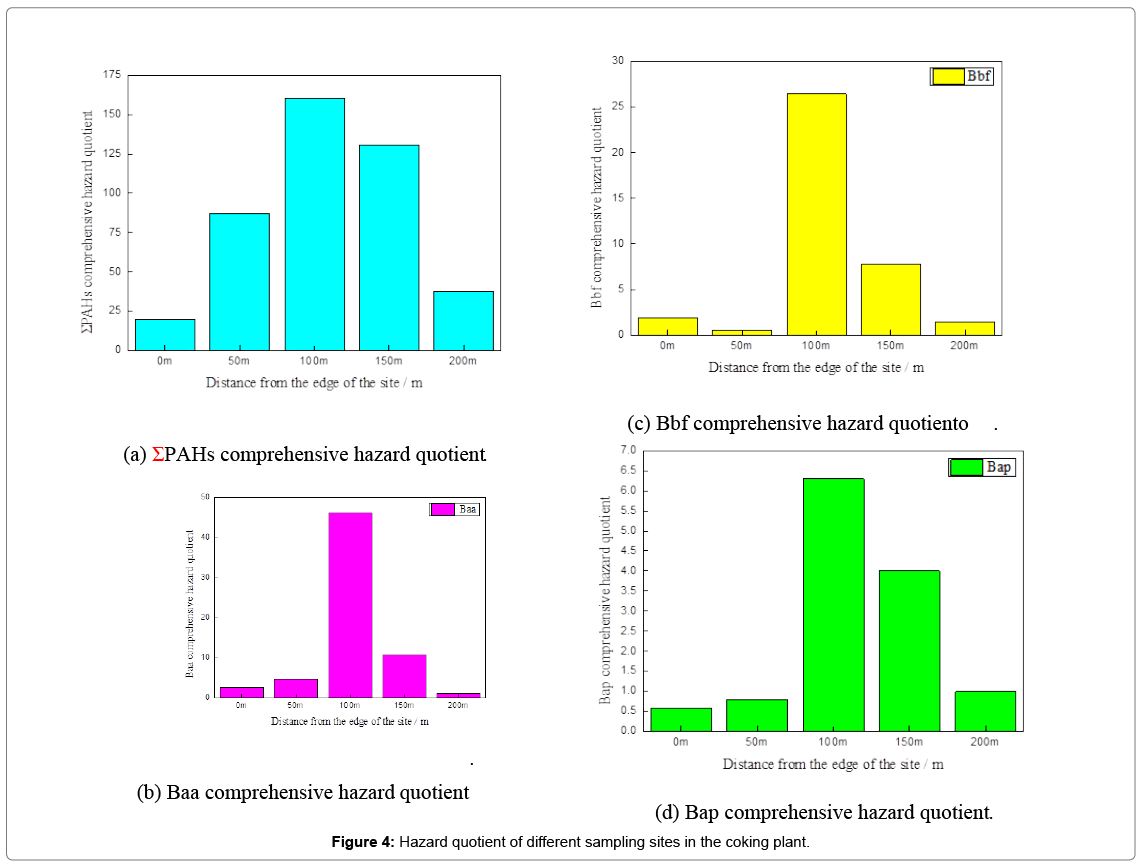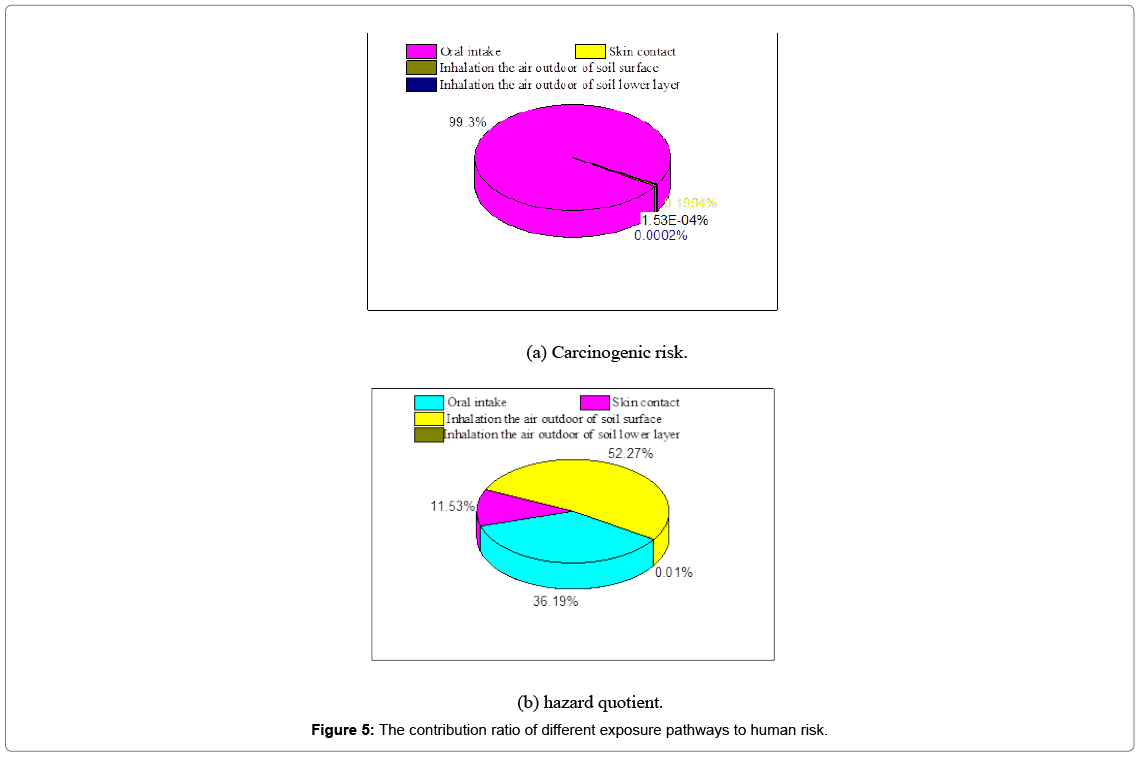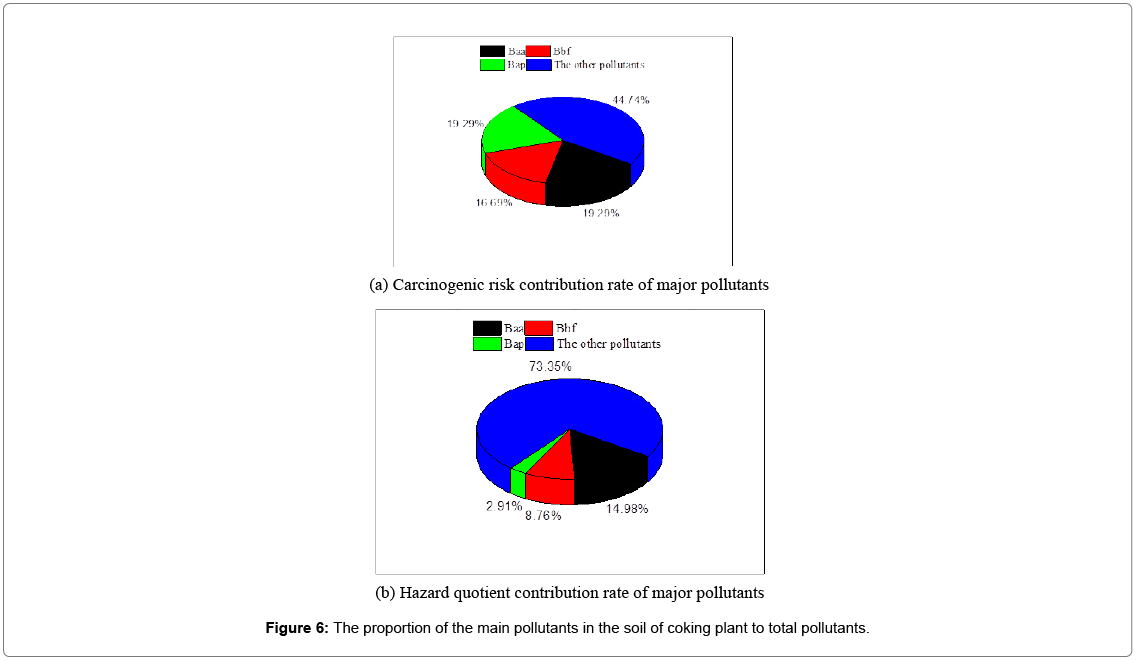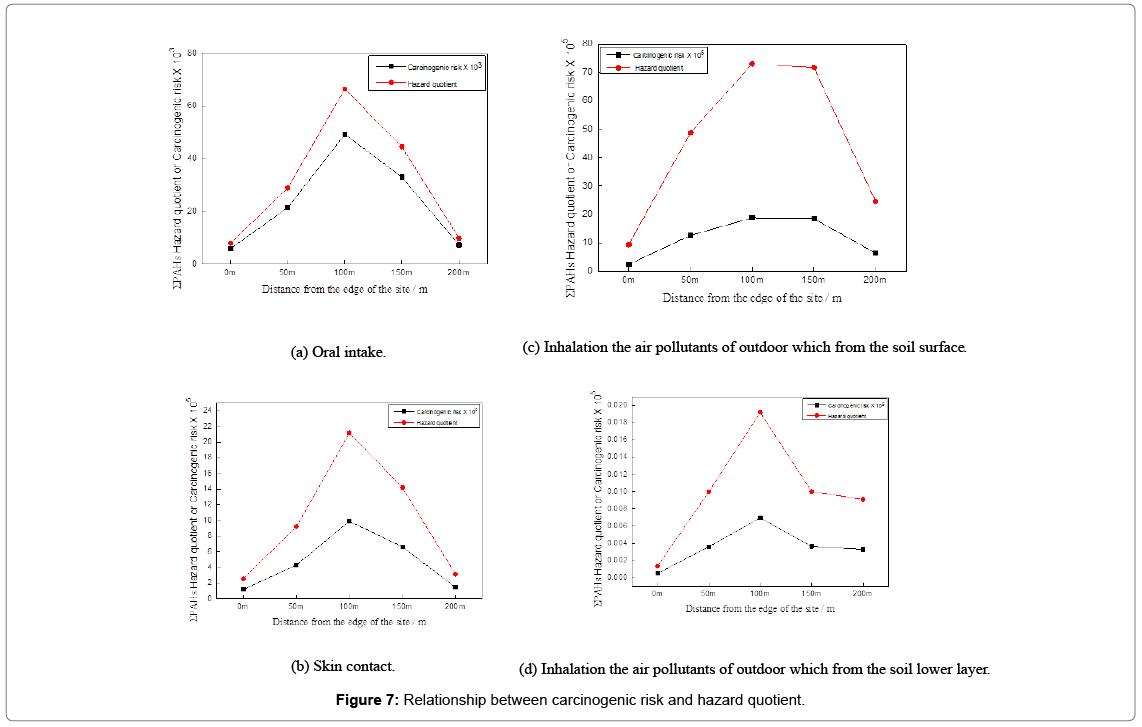Research Article Open Access
Human Health Risk Levels and Distribution of PAHs in Soil Environment of a Coking Chemical Plant Located in Beijing, China
Jianli Jia1*, Haibin He1, Zihao Wang1, Shenwei Zhao1, Linying Me1, Jialin Liu1, Shihai Zhang1, Cunzhen Liang2 and Yinghua Zhang3
1School of Chemical and Environmental Engineering, China University of Mining and Technology (Beijing), Beijing 100083, PR China
2Beijing Institute of Petrochemical Technology, Beijing 102671, PR China
3Institute of Geographic Sciences and Natural Resources Research, Chinese Academy of Sciences, Beijing 100864, PR China
- *Corresponding Author:
- Jianli Jia
School of Chemical and Environmental Engineering
China University of Mining and Technology (Beijing)
Beijing 100083, PR China
Tel: 13810103722
E-mail: jiajianli77@126.com
Received Date: July 27, 2017; Accepted Date: August 22, 2017; Published Date: August 24, 2017
Citation: Jia J, He H, Wang Z, Zhao S, Me L, et al. (2017) Human Health Risk Levels and Distribution of PAHs in Soil Environment of a Coking Chemical Plant Located in Beijing, China. J Bioremediat Biodegrad 8:407. doi: 10.4172/2155- 6199.1000407
Copyright: © 2017 Jia J, et al. This is an open-a ccess article distributed under the terms of the Creative Commons Attribution License, which permits unrestricted use, distribution, and reproduction in any medium, provided the original author and source are credited.
Visit for more related articles at Journal of Bioremediation & Biodegradation
Abstract
In this study, the polycyclic aromatic hydrocarbons (PAHs) organic pollutants in soil samples were determined by Soxhlet extraction- GCMS methods. Human health risks of as for 5 different sampling sites in the coking chemical plant were evaluated in four major Exposure routes, including oral intake, skin contact, inhalation the air pollutants of outdoor which from the soil surface, and inhalation the air pollutants of outdoor which from the soil lower layer. The results showed that the detection rate of 16 kinds precedent- controlled PAHs in the US Environmental Protection Agency was 100%. The three main pollutants are Baa, Bbf, Bap. The ΣPAHs comprehensive carcinogenicity risk of the oral exposure pathway is 498 times the carcinogenic risk of the skin exposure pathway, and 198 times the rate of carcinogenic risk of inhalation of soil particle Exposure route. And the rate of carcinogenic risk of Inhalation the air pollutants of outdoor which from the soil lower layer is almost 0. The hazard quotient of soil ΣPAHs main air pollutants pathway are oral intake and inhalation of outdoor air from the soil surface. The sum of them is close to 90%, The hazard quotient of soil ΣPAHs in the coking plant area is seriously exceeded. The risk of ΣPAHs in the soil of coking plant was mainly exposed to oral intake, and the contribution rate of carcinogenic risk was 99.3103%. Combined with the development characteristics of China's coking industry, regional climate and geological characteristics, make a human health risk assessment to ΣPAHs.
Keywords
Carcinogenic risk; Hazard quotient; Coking industry; PAHs; Soil
Introduction
Polycyclic aromatic hydrocarbons (PAHs) refers to the molecular structure is composed of two or more benzene rings composed of a class of typical persistent toxic substances [1], mainly from fossil fuels and biomass incomplete combustion. In 1976, the US Environmental Protection Agency (EPA) included 16 PAHs in the blacklist of organic pollutants [2,3], and seven of these PAHs were included in the "Blacklist for Environmental Priorities in China" [4]. Soil as a complex multi- media multi- interface system, rich in organic matter, easy to adsorb lipophilic organic pollutants, So the soil becomes an important environment for PAHs, It’s difficult to available the PAHs those remaining in the soil, Accompanied by food chain or food network into the body, Of course, some of them into the body through the breathing, thus becoming a potential carcinogen, endangering human health. PAHs which were produced by activities such as human production and life can enter the soil through sewage discharge, wet and dry sedimentation and etc. And the soil carries more than 90% of the PAHs environmental load [5]. The results show that the content of PAHs in the soil has gradually increased in recent decades [6], and the soil has become an important medium for PAHs to enter the human body. PAHs entering the soil can be divided into two groups: soil- water- human body and soil- crophuman, which have a certain threat to the human health, so more and more scholars whom at home and abroad pay attention to the PAHs, and the related research has great theoretical and practical significance. There have been a lot of researches on the content, distribution, source analysis, ecological risk assessment, migration and transformation mechanism of PAHs in soil. The results of domestic studies are mainly on the relationship between PAHs content, distribution and PAHs which were in rivers, lakes, ground water and sediments. The PAHs source analysis and human health risk assessment of soils affected by industrial pollution Research is rare. The research on soil pollution in coal mining and utilization area is mainly focused on the conventional pollution such as heavy metal, soil physical and chemical properties and microbial characteristics, And PAHs for human health risk assessment rarely reported. Therefore, it is important to study the safety and health of the workers and their surrounding residents in the coking plant area during the coking process. It is an important basis for the safety and effective promotion of China's energy strategy [7].
The coking plant of Beijing was selected to evaluate the carcinogenic risk, and field sampling, monitoring, selection and improvement of human health risk assessment model to assess the carcinogenic risk and hazard quotient, the risk control values of different exposure routes were calculated, and calculate the risk control values for different exposure routes. And provide the basis for soil environmental management in China's coking area [8,9]. At the same time, it will provide the basis for the bioremediation, key technology selection and repair standard of the coking site in the future.
Materials and Methods
Sample collection
The soil samples were collected from a coking plant which site in Beijing on March 10, 2017 (N39°51'21'', E116°31'43''). The coking plant is located in Chaoyang District, Beijing Chemical Road East, and it has been discontinued for soil remediation. The specific location shown in Figure 1. The coking plant sampling points shown in Figure 2. Starting at 0 m from the edge of the field (0 m also as a sampling point), Setting a sampling point every 50 meters, thus there are 50 m, 100 m, 150 m, 200 m five sampling points (Figure 2), And then use soil drilling and ring knife to sample the soil profile. The samples were collected from 4 to 20 cm, 40 to 70 cm, 70 to 100 cm and 100 to 120 cm (the isolated layer of cinder at 20 to 40 cm did not be sampled) [10], put into the selfcontained bag, transported to the laboratory to test, inspection. In this experiment, a total of two sets of parallel experiments were conducted, and the average values were analyzed.
Sample test materials and methods
The extraction of PAHs in soil samples is based on the environmental standard HJ 805-2016. And analyzed by gas chromatography-mass spectrometry, there is extraction method summarized:Take the appropriate amount of soil into the freeze dryer, after 24 h, remove the gravel and plant roots and other debris, the freeze-dried soil samples were crushed with a pulverizer. Add 1 μg of the mixture (M- d12: M-naphthalene-d12=1:1) to 10 g soil samples, placed overnight; the soil is wrapped with filter paper, the bottom of the filter paper bucket put a small piece of absorbent cotton to prevent the bottom of the filter were damaged under the soil; Place the filter drum in the Soxhlet extractor cartridge, A 100 ml mixture of acetone: n-hexane=1:1 was added to a flat-bottomed flask, then continuous extraction of 16 h, The extract was once again dehydrated with anhydrous sodium sulfate, concentrated to about 1 mL with a rotary evaporator, and passed through a 0.5 μm fiber membrane, and then put the sample into glass bottles to be measured.
Human health risk assessment method
In this study, the mainstream models and methods of risk assessment of contaminated sites were compared by reference to RBCA [11-13], Csoil [11,14], CLEA [12,15] and HERA [16] which at home and abroad. Based on the Technical Guidelines for Risk Assessment of Contaminated Sites (HJ25.3- 2014) [17], according to China's coking process and its pollution characteristics approved site type, choose to determine the exposure path to calculate the exposure, assess the carcinogenic risk and hazard quotient, calculate the risk control value, based on this, the contribution rate of carcinogenic risk of PAHs under different Exposure route was analyzed. Constructing the human health risk assessment method of PAHs in the soil environment surrounding the coking industry unit in China, and provides the technical basis for the health risk assessment and prevention of PAHs in coking plant area in China.
Exposure route selection and exposure calculation: The site of coking plant is the target site of this study. Belonging to industrial land in non- sensitive land, According to the recommended non- sensitive land in the guidelines for the assessment of human health risks in contaminated sites. Taking into account the coking plant near the surface without water off, groundwater is not the actual situation of drinking water, combined with the literature has been reported [17,18], this study selects oral intake, skin contact, inhalation the air pollutants of outdoor which from the soil surface, and inhalation the air pollutants of outdoor which from the soil lower layer etc. Exposure route [19-21], Evaluating the human health risk of PAHs.
For carcinogenic and non- carcinogenic effects of a single contaminant, calculating oral intake, skin contact, inhalation the air pollutants of outdoor which from the soil surface, and inhalation the air pollutants of outdoor which from the soil lower layer etc. four exposure routes corresponding to the soil exposure of the recommended model were shown in Table 1.
| Formula number | Exposure route | Formula Description | Exposure formula expression |
|---|---|---|---|
| 1 | Oral intake | Carcinogenic risk |  |
| 2 | Non-carcinogenic risk |  |
|
| 3 | Skin contact | Carcinogenic risk |  |
| 4 | Non-carcinogenic risk |  |
|
| 5 | Inhalation the air pollutants of outdoor which from the soil surface | Carcinogenic risk |  |
| 6 | Non-carcinogenic risk |  |
|
| 7 | inhalation the air pollutants of outdoor which from the soil lower layer | Carcinogenic risk |  |
| 8 | Non-carcinogenic risk |  |
Table 1: Calculating models of soil exposure dose in three soil Exposure routes.
The main parameters of the risk assessment model of contaminated sites include target pollutant concentration, toxicological parameters of pollutants, site condition parameters, exposure parameters and so on. The target pollutant concentration and site condition parameters are the actual measured values, the site is industrial land, Belonging to nonsensitive sites. So, exposure factor parameters are not considered for child exposure, only select adults as target, the specific values in Table 2.
| Parameter | Implication | Value | Unit |
|---|---|---|---|
| OSIRa | Adult daily intake of soil | 100 | mg/d |
| EDa | Adult exposure period | 25 | a |
| EFa | Adult exposure frequency | 250 | d/a |
| BWa | Adult weight | 56.8 | kg |
| ABS0 | Oral intake absorption efficiency factor | 26280 | / |
| ATca | The average time for carcinogenic effects | 26280 | d |
| ATnc | The average time for non – carcinogenic effects | 91280 | d |
| SAEa | Adult exposed skin surface area | 2854.62 | cm2 |
| SSARa | Adhesive coefficient of adult skin surface soil | 0.2 | mg/cm2 |
| ABSd | Skin contact absorption efficiency factor | 0.03 | / |
| Ev | Daily skin contact event frequency | 1 | d |
| DAIRa | Adult daily air intake | 14.5 | m3/d– 1 |
| PIAF | Inhalation of soil particles in the body retention ratio | 0.75 | / |
| fspo | The proportion of particulate matter from the soil in the outdoor air | 0.5 | / |
| EFOa | Adult outdoor exposure frequency | 62.5 | d/a |
| Csur | Concentration of contaminants in surface soils | x | mg/kg |
| SF0 | Oral intake of carcinogenic slope factor | 1.5 | ├»┬╝┬?mg/kg-d)-1 |
| SFd | Skin contact carcinogenic slope coefficient | 1 | ├»┬╝┬?mg/kg-d)-1 |
| SFi | Respiratory inhalation carcinogenic slope factor | 4.3 | ├»┬╝┬?mg/kg-d)-1 |
| SAF | The reference dose distribution coefficient for exposure to soil | 0.2 | / |
| RfD0 | Oral intake of reference | 3.00E-4 | mg/kg-d |
| RfDd | Skin contact reference | 3.00E-4 | mg/kg-d |
| RfDi | Respiratory inhalation reference | 3.83E-6 | mg/kg-d |
| VFsuroa | Evaporation of pollutants in the surface soil into the outdoor air | Table3 | kg/m3 |
| VFsuboa | Evaporation of pollutants in the lower soil into the outdoor air | Table3 | kg/m3 |
Table 2: Major parameters in the exposure dose calculation models.
Risk characterization and risk contribution rate accounting: The parameters of exposure parameters were calculated and calculated under different exposure routes, According to the test and analysis data of PAHs of soil samples at each sampling point, The carcinogenic risk and hazard quotient of PAHs in different exposure pathways were calculated by the formulas listed in Table 3, Calculating the single path of human carcinogenic risk and hazard quotient as the human health risk of PAHs in multi - exposure pathway of coking plant [22]. The health risk level of PAHs at each sampling station was analyzed. And the risk level of each sample point was compared with the acceptable level of human carcinogen risk (1 × 10-6) and acceptable hazard quotient (1) [17,23].
| Compound abbreviation | Evaporation of pollutants in the surface soil into the outdoor air (VFsuroa) | Evaporation of pollutants in the lower soil into the outdoor air (VFsuboa) |
|---|---|---|
| Nap | 3.80518E-05 | 2.50183E-08 |
| Acpy | - | - |
| Acp | 2.55194E-05 | 2.68689E-09 |
| Flu | 1.76401E-05 | 1.28384E-09 |
| Phe | - | - |
| Ant | 6.84754E-06 | 1.93455E-10 |
| Fl | 1.29843E-06 | 6.95585E-12 |
| Pyr | 1.51192E-06 | 9.43129E-12 |
| Baa | 1.11776E-06 | 5.15467E-12 |
| Chr | 5.52505E-07 | 1.25947E-12 |
| Bbf | 1.68372E-07 | 1.16961E-13 |
| Bkf | 1.63824E-07 | 1.10727E-13 |
| Bap | 1.52364E-07 | 9.57768E-14 |
| Ind | 9.43315E-08 | 3.6713E-14 |
| Dba | 6.39431E-08 | 1.68678E-14 |
| Bghip | - | - |
Table 3: Surface soil and lower soil Volatile factors.
As is shown in the Table 4, CRois-Carcinogenic risk of oral intake, Dimensionless; CRdcs-Carcinogenic risk of skin contact pathways, Dimensionless; CRiov1-Carcinogenic risk of inhalation the air pollutants of outdoor which from the soil surface, Dimensionless; CRiov2-Inhalation the air pollutants of outdoor which from the soil lower layer, Dimensionless; HQois-Hazard quotient of oral intake route, Dimensionless. HQdcs-Hazard quotient of Skin contact route, Dimensionless. HQiov1-Hazard quotient of inhalation the air pollutants of outdoor which from the soil surface, Dimensionless; HQiov2-Hazard quotient of inhalation the air pollutants of outdoor which from the soil lower layer, Dimensionless.
| Formula number | Exposure route | Formula Description | Exposure formula expression |
|---|---|---|---|
| 9 | Oral intake | Carcinogenic risk |  |
| 10 | Hazard quotient |  |
|
| 11 | Skin contact | Carcinogenic risk |  |
| 12 | Hazard quotient |  |
|
| 13 | Inhalation the air pollutants of outdoor which from the soil surface | Carcinogenic risk |  |
| 14 | Hazard quotient |  |
|
| 15 | Inhalation the air pollutants of outdoor which from the soil lower layer | Carcinogenic risk |  |
| 16 | Hazard quotient |  |
Table 4: Cancer risk and hazard quotient calculating formulas for four soil exposure pathways.
Based on total carcinogenic risk level, calculating separately the contribution rate of carcinogenic risk in the four exposure pathways (Formula 1), analyzing and determining the main contribution path to provide the basis for the follow- up risk prevention and control.
 (Formula 1)
(Formula 1)
And Ri-The contribution rate of carcinogenic risk or hazard quotient under the exposure pathways, Dimensionless; CRi-The level of carcinogenic risk or hazard quotient under the exposure pathways, Dimensionless. ΣCRi-Total carcinogenic risk or total hazard quotient.
Risk control value calculation: When the level of carcinogenic risk or hazard quotient exceeds the acceptable level, the risk control value for the corresponding exposure pathway should be calculated (Table 5).
| Formula number | Exposure pathways | Formula Description | Risk control value calculation formula |
|---|---|---|---|
| 17 | Oral intake | Carcinogenic risk |  |
| 18 | Hazard quotient |  |
|
| 19 | Skin contact | Carcinogenic risk |  |
| 20 | Hazard quotient |  |
|
| 21 | Inhalation the air pollutants of outdoor which from the soil surface | Carcinogenic risk |  |
| 22 | Hazard quotient |  |
|
| 23 | Inhalation the air pollutants of outdoor which from the soil lower layer | Carcinogenic risk |  |
| 24 | Hazard quotient |  |
Table 5: Safety threshold calculating formulas for three soil exposure pathways.
Results and Discussion
Characteristics and PAHs content in coking plant
The contents of soil pH, water and PAHs in the sampling sites of coking plant are shown in Table 6. The results showed that soil in coking plant is basically weak acidity, pH distribution between 6.5-7, soil moisture content is generally low, the moisture content of 14 samples are between 10% and 20%, and 15% of the total sample are less than 5%, The PAHs content in the soil of the coking plant was 0.88-447.24 mg/kg, The content of Baa at 100 m was 447.24 mg/kg, and the content of Bbf at 100 m was 380.29 mg/kg, There is little difference between 0 m sampling and 200 m sampling of ΣPAHs content, but the ΣPAHs content at 100 m was the largest.
| Sampling point(m) | pH | Moisture content% | types of pollutant | Average content (mg/kg) | Oral intake | Skin contact | Inhalation the air pollutants of outdoor which from the soil surface | Inhalation the air pollutants of outdoor which from the soil lower layer | ||||
|---|---|---|---|---|---|---|---|---|---|---|---|---|
| Carcinogenic risk | Hazard quotient | Carcinogenic risk | Hazard quotient | Carcinogenic risk | Hazard quotiet | Carcinogenic risk | Hazard quotient | |||||
| 0m | 6.7 | 15.51 | ∑PAHs | 164.80 | 5.88E-03 | 7.94 | 1.18E-05 | 2.53 | 2.42E-05 | 9.37 | 4.80E-09 | 1.33E-03 |
| Baa | 25.06 | 8.94E-04 | 1.21 | 1.80E-06 | 0.38 | 2.56E-06 | 0.99 | 1.66E-11 | 4.58E-06 | |||
| Bbf | 27.68 | 9.87E-04 | 1.33 | 1.98E-06 | 0.42 | 4.26E-07 | 0.17 | 4.15E-13 | 1.15E-07 | |||
| Bap | 8.48 | 3.03E-04 | 0.41 | 6.08E-07 | 0.13 | 1.18E-07 | 0.05 | 1.04E-13 | 2.88E-08 | |||
| 50m | 6.8 | 13.33 | ∑PAHs | 599.07 | 2.14E-02 | 28.86 | 4.30E-05 | 9.20 | 1.26E-04 | 48.87 | 3.61E-08 | 9.97E-03 |
| Baa | 45.15 | 1.61E-03 | 2.17 | 3.24E-06 | 0.69 | 4.61E-06 | 1.79 | 2.98E-11 | 8.25E-06 | |||
| Bbf | 8.21 | 2.93E-04 | 0.40 | 5.89E-07 | 0.13 | 1.26E-07 | 0.05 | 1.23E-13 | 3.40E-08 | |||
| Bap | 11.45 | 4.09E-04 | 0.55 | 8.21E-07 | 0.18 | 1.59E-07 | 0.06 | 1.41E-13 | 3.89E-08 | |||
| 100m | 7 | 10.14 | ∑PAHs | 1378.9 | 4.92E-02 | 66.42 | 9.89E-05 | 21.17 | 1.88E-04 | 73.04 | 6.96E-08 | 1.92E-02 |
| Baa | 447.24 | 1.60E-02 | 21.54 | 3.21E-05 | 6.87 | 4.57E-05 | 17.71 | 2.96E-10 | 8.17E-05 | |||
| Bbf | 380.29 | 1.36E-02 | 18.32 | 2.73E-05 | 5.84 | 5.85E-06 | 2.27 | 5.70E-12 | 1.58E-06 | |||
| Bap | 91.49 | 3.26E-03 | 4.41 | 6.56E-06 | 1.40 | 1.27E-06 | 0.49 | 1.12E-12 | 3.10E-07 | |||
| 150m | 6.9 | 11.57 | ∑PAHs | 923.79 | 3.30E-02 | 44.50 | 6.62E-05 | 14.18 | 1.85E-04 | 71.80 | 3.63E-08 | 1.00E-02 |
| Baa | 104.48 | 3.73E-03 | 5.03 | 7.49E-06 | 1.60 | 1.07E-05 | 4.14 | 6.91E-11 | 1.91E-05 | |||
| Bbf | 112.09 | 4.00E-03 | 5.40 | 8.04E-06 | 1.72 | 1.72E-06 | 0.67 | 1.68E-12 | 4.64E-07 | |||
| Bap | 58.02 | 2.07E-03 | 2.79 | 4.16E-06 | 0.89 | 8.08E-07 | 0.31 | 7.13E-13 | 1.97E-07 | |||
| 200m | 6.5 | 5.75 | ∑PAHs | 204.11 | 7.28E-03 | 9.83 | 1.46E-05 | 3.13 | 6.31E-05 | 24.48 | 3.29E-08 | 9.10E-03 |
| Baa | 10.71 | 3.82E-04 | 0.52 | 7.68E-07 | 0.16 | 1.09E-06 | 0.42 | 7.08E-12 | 1.96E-06 | |||
| Bbf | 20.62 | 7.35E-04 | 0.99 | 1.48E-06 | 0.32 | 3.17E-07 | 0.12 | 3.09E-13 | 8.54E-08 | |||
| Bap | 14.39 | 5.13E-04 | 0.69 | 1.03E-06 | 0.22 | 2.00E-07 | 0.08 | 1.77E-13 | 4.88E-08 | |||
Table 6: Sample test and evaluation results.
Human health risk assessment of soil in coking plant
Carcinogenic risk: According to Tables 1-4 evaluation methods and the main parameters selected, combined with guide recommendations and on-site collection, sample test results, calculating oral intake, skin contact, inhalation the air pollutants of outdoor which from the soil surface, and inhalation the air pollutants of outdoor which from the soil lower layer etc. four Exposure pathways to carcinogenic risk, and calculated by summing method (Figure 3).
As is shown in Table 5 and Figure 3, the Multi-way of total carcinogenic risk of PAHs was distributed between 5.92 × 10-3-4.9 × 10-2, and the total carcinogenic risk exceeded the acceptable level (1 × 10-6), The carcinogenic risk of ΣPAHs in soil samples at 100 m was higher than that in the other four sampling sites, and the risk level of the samples at 0 m and 200 m was close, The carcinogenic risk of Baa was between 3.84 × 10-4 and 1.60 × 10-2, Exceed acceptable level (1 × 10-6), the carcinogenic risk at 100 m was the highest, The carcinogenic risk of Bbf was between 2.94 × 10-4-1.36 × 10-2, Exceed acceptable level (1 × 10-6), the carcinogenic risk at 100 m was the highest; The carcinogenic risk of Bap was between 2.94 × 10-4 and 1.36 × 10-2, the carcinogenic risk at 100 m was the highest.
Hazard quotient: According to Tables 1-4 evaluation methods and the main parameters selected, combined with guide recommendations and on-site collection, sample test results, calculating oral intake, skin contact, inhalation the air pollutants of outdoor which from the soil surface, and inhalation the air pollutants of outdoor which from the soil lower layer etc. four Exposure pathways to hazard quotient, and calculated by summing method (Figure 4).
As is shown in Table 5 and Figure 4, the Multi-way of total hazard quotient of PAHs was distributed between 19.84 and 160.64, which is beyond the acceptable range (acceptable to 1), The highest value of PAHs is 160.64. The Figures 4b-4d shows that hazard quotient is the largest at 100 m. In general, the level of ΣPAHs in the coking plant area is extremely high, so it is necessary to pay attention to it. It is necessary to attach great importance to the shortcomings of the coking plant in the soil environment. The input and accumulation of soil environment may lead to increase the hazard quotient of PAHs in the soil. Meanwhile, measures should be taken to ensure that the plant staff health and safety.
The contribution rate of human health risk for every exposure pathway: The contribution rate of carcinogenic risk and hazard quotient of PAHs in different exposure pathways were calculated by the formulas listed in Figure 5, And provide the basis for targeted prevention and control of human health risk in coking plant area.
The risk of ΣPAHs in the soil of coking plant was mainly exposed to oral intake, and the contribution rate of carcinogenic risk was 99.3103%. The ΣPAHs comprehensive carcinogenicity risk of the oral exposure pathway is 498 times the carcinogenic risk of the skin exposure pathway, and 198 times the rate of carcinogenic risk of inhalation of soil particle Exposure route. And the rate of carcinogenic risk of Inhalation the air pollutants of outdoor which from the soil lower layer is almost 0. The hazard quotient of soil ΣPAHs main air pollutants pathway are oral intake and inhalation of outdoor air from the soil surface. The sum of them is close to 90%, The hazard quotient of soil ΣPAHs in the coking plant area is seriously exceeded.
It can be seen from Figure 6 that the carcinogenic risk of Baa, Bbf, Bap three main pollutants accounted for 55.26% of total pollutants; And the hazard quotient of Baa, Bbf, Bap three main pollutants accounted for 26.65% of total pollutants.
In summary, as for the human health risk of ΣPAHs in coking plant, Inhalation of outdoor air from the soil surface of the air pollutants is the most important exposure pathways, it should be controlled and prevention in the coking production process. In addition, three main pollutants of Baa, Bbf, Bap were main controlled, and taking into account the relevant areas of the study and the main exposure pathways for ΣPAHs of human health risks, the main risk control means to block the inhalation the air pollutants of outdoor which from the soil surface and oral intake of exposure pathways, such as wearing a safety mask.
The relationship between carcinogenic risk and Hazard quotient of ΣPAHs in each exposure pathway: In order to more intuitively analyze the relationship between carcinogenic risk and Hazard quotient of ΣPAHs in each exposure pathway, the analysis will expand the appropriate multiple, analyze and explore the changes.
It can be seen from Figure 7 that the carcinogenic risk of ΣPAHs in this plant is directly proportional to hazard quotient, The greater the carcinogenic risk value, the greater the hazard quotient, but the two non-fixed function. The carcinogenic risk and hazard quotient are the bigges in 100 m, the remediation of soil in this area should be paid more attention.
Conclusions
• The detection rate of 16 kinds precedent- controlled PAHs in the US Environmental Protection Agency was 100%. And the carcinogenic risk of Baa, Bbf, Bap three main pollutants accounted for 55.26% of total pollutants; And the hazard quotient of Baa, Bbf, Bap three main pollutants accounted for 26.65% of total pollutants.
• The ΣPAHs comprehensive carcinogenicity risk of the oral exposure pathway is 498 times the carcinogenic risk of the skin exposure pathway, and 198 times the rate of carcinogenic risk of inhalation of soil particle Exposure route. And the rate of carcinogenic risk of inhalation the air pollutants of outdoor which from the soil lower layer is almost 0. The hazard quotient of soil ΣPAHs main air pollutants pathway are oral intake and inhalation of outdoor air from the soil surface. The sum of them is close to 90%, The hazard quotient of soil ΣPAHs in the coking plant area is seriously exceeded.
• The four carcinogenic risk exposure pathways are oral intake, skin contact, inhalation the air pollutants of outdoor which from the soil surface, and inhalation the air pollutants of outdoor which from the soil lower layer, the contribution rate of carcinogenic risk was 99.3103%. Referring to the contribution rate of each exposure route, oral intake and inhalation the air pollutants of outdoor which from the soil surface are the main exposure route of human health risks, Therefore, while reducing the risk level of exposure pathway pollutant, Meanwhile, it should strengthen protect the plant operator, through wearing masks and other measures to block or reduce the oral intake and inhalation exposure pathways.
• The carcinogenic risk of ΣPAHs in this plant is directly proportional to hazard quotient, The greater the carcinogenic risk value, the greater the hazard quotient, but the two nonfixed function. The carcinogenic risk and hazard quotient are the biggest in 100 m, the remediation of soil in this area should be paid more attention to.
Acknowledgments
The authors thank National Basic Research Program of China (973 Program, No. 2014CB238906), National Natural Science Foundation of China (No. 41601336) for financial support.
References
- Kumar B, Verma VK, Kumar S, Sharma CS (2013) Probabilistic health risk assessment of polycyclic aromatic hydrocarbons and polychlorinated biphenyls in urban soils from a tropical city of India. Journal of Environmental Science and Health, Part A 48: 1253-1263.
- Yan-Wei H, You-Xia Z (2012)Prusion Characteristics and Risk Analysis of PAHs in Surface Soil of a Steel Plant in Fujian. Environmental Chemistry 10:1542-1548.
- Feng Y, Lu Y, Jiao W, Wang T, Wang G, et al. (2009) Distribution and Risk Assessment of Polycyclic Aromatic Hydrocarbons (PAHs) in Different Workshop Soils of a Waste Coking Plant in Beijing. Journal of Ecotoxicology3:399-407.
- Min Y, Hong Z, Zhu R, Su W (2003) Hazard and Prevention of Polycyclic Aromatic Hydrocarbons. Journal of Capital Normal University24:40-44.
- Wild SR, Jones KC (1995) Polynuclear aromatic hydrocarbons in the United Kingdom environment a preliminary source inventory and budget. Environmental Pollution88:91-108.
- Jones KC, Stratford JA, Waterhouse KS, Furlong ET, Giger W, et al. (1989) Increases in the polynuclear aromatic hydrocarbon content of an agricultural soil over the last century. Environmental Science & Technology 23: 95-101.
- Kulhánek A, Trapp S, Sismilich M, Jank├?┬» J, Zimová M (2005) Crop-specific human exposure assessment for polycyclic aromatic hydrocarbons in Czech soils. Science of the Total Environment 339: 71-80.
- Jia J, Li X, Yang L, Hu L, Zhao SW, et al. (2016) Soil northwest China region in a coal chemical arsenic risk to human health and the safety threshold. Earth Science Frontiers 23:124-132.
- Jia J, Li X, Wu P, Liu Y, Han C, et al. (2015) Human health risk assessment and safety threshold of harmful trace elements in the soil environment of the Wulantuga open-cast coal mine. Minerals 5: 837-848.
- Liu G, Niu J, Guo W, An X, Zhao L (2016) Ecological and health risk-based characterization of agricultural soils contaminated with polycyclic aromatic hydrocarbons in the vicinity of a chemical plant in China. Chemosphere 163: 461-470.
- Yi-ZhongW, Xiao Liang T, Ying GE(2011) Comparison of RBCA and Csoil Models in Health Risk Assessment of Volatile Organic Pollutants. Journal of Agricultural Environmental Sciences 30:2458-2466.
- Cao Y, Zhang J(2009) Comparison of RBCA and CLEA Models in Environmental Risk Assessment of Heavy Metal Contaminated Sites.Environmental Sciences 22:241-247.
- Lemke LD, Bahrou AS (2009) Partitioned multi objective risk modeling of carcinogenic compounds in groundwater. Stochastic Environmental Research and Risk Assessment 23: 27-39.
- Waitz MFW, Freijer JI, Kreule P, Swartjes FA (1996) The VOLASOIL risk assessment model based on CSOIL for soils contaminated with volatile compounds. RIVM Rapport,pp: 7158-10014.
- Ming Z, Tian-Tian C, Lin S(2013) CLEA model and its application in China. Journal of University of Chinese Academy of Sciences 30:779-785.
- Meng-Fang C, Yong-Ming L, Jing S(2011) Theory and Common Model of Soil General Assessment Basis for Contaminated Sites. Environmental Monitoring Management and Technology 23:19-25.
- National Environmental Protection Standard of the People's Republic of China (2014) Technical Guidelines for Risk Assessment of Contaminated Sites.
- You-Ning X, Jiang-Hua Z, Hai-Ling KE, Hua-Qing C, Gang Q, et al. (2014)Human health risk of heavy metal pollution in farmland soil in a gold mining area. Journal of Geology and Mineral Resources8:1239-1252.
- IARC (2006) Polycyclic Aromatic Hydrocarbons. IARC Monographs, Lyone, France.
- Singh VK, Anand M, Rawtani D, Singh UP, Patel DK, et al. (2011) Blood levels of polycyclic aromatic hydrocarbons in women with benign and malignant breast lesions: A case-control study. Asian Journal of Medical Sciences 1: 80-86.
- Gale SL, Noth EM, Mann J, Balmes J, Hammond SK, et al. (2012) Polycyclic aromatic hydrocarbon exposure and wheeze in a cohort of children with asthma in Fresno, CA. Journal of Exposure Science &Environmental Epidemiology 22: 386-392.
- Kang Y, Liu G, Chou CL, Wong MH, Zheng L, et al. (2011) Arsenic in Chinese coals: distribution, modes of occurrence, and environmental effects. Science of the Total Environment 412: 1-13.
- USEPA (2005) Guidelines for Carcinogen Risk Assessment.
Relevant Topics
- Anaerobic Biodegradation
- Biodegradable Balloons
- Biodegradable Confetti
- Biodegradable Diapers
- Biodegradable Plastics
- Biodegradable Sunscreen
- Biodegradation
- Bioremediation Bacteria
- Bioremediation Oil Spills
- Bioremediation Plants
- Bioremediation Products
- Ex Situ Bioremediation
- Heavy Metal Bioremediation
- In Situ Bioremediation
- Mycoremediation
- Non Biodegradable
- Phytoremediation
- Sewage Water Treatment
- Soil Bioremediation
- Types of Upwelling
- Waste Degredation
- Xenobiotics
Recommended Journals
Article Tools
Article Usage
- Total views: 3951
- [From(publication date):
September-2017 - Apr 04, 2025] - Breakdown by view type
- HTML page views : 3032
- PDF downloads : 919

